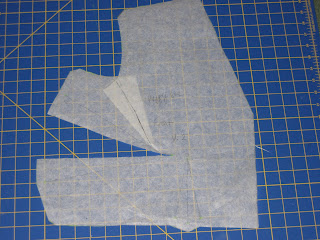One of the things we got was a lovely big globe eggplant. I love eggplant, but I've never cooked it. Hurray for experiments and new food! J isn't wild about eggplant normally, but seems to like it ok when it's in stuff rather than just on it's own. I mulled over what to do with it for a while and then I thought: Moussaka!
For those who don't know, moussaka is a greek casserole similar to lasagne that uses eggplant instead of noodles. Traditionally it is made by frying the eggplant slices and layering them with a rich tomato sauce with ground lamb. It's then covered in a cheesy bechamel sauce. It is yummy, but really rich and heavy. Very much a fall comfort food kind of dish.
So I came up with this lighter, vegetarian version that makes use of all the wonderful summer produce we have available in Northern California right now. I substitute tons of veggies for the meat and grill the eggplant instead of frying it for less oil and a nice charred flavor. I made my trip to the farmers market to supplement my CSA stash and cooked it up. It takes a longish time (about 45 minutes to prep with one person) and multiple steps, but if you've got a lazy day and you feel like cooking, give it a try. You should eat this in a bowl with a spoon, 'cause it'll be a little bit soupy.
Here it is done! This makes approximately 12 servings. Unless you're like me and you want to eat it all because it's just that darned good!

California Summer Moussaka
Ingredients:
1 large globe eggplant
3 medium-ish carrots, chopped in 1/4 inch pieces
1 medium yellow onion, chopped
2 large cloves garlic minced
1 lb assorted summer squash (I used green and yellow zucchini and pattypans), chopped
3 large juicy tomatoes chopped (I used random big dark pink heirlooms. No idea what kind they were, but they were juicy and sweet!)
1/2 tsp ground clove
1/2 tsp ground cinnamon
1/2 tsp dried oregano
1/2 tsp dried marjoram
1 tbsp fresh oregano
1 tbsp fresh majoram
kosher or sea salt to taste
Bechamel sauce (recipe follows)
breadcrumbs (optional)
1. Prepare the eggplant: cut the top and bottom off the eggplant to make it stable. Peel it and slice it into 1/4 inch thick slices. Place the slices on a platter covered in paper towel and sprinkle them with salt. Let them sit for 30 minutes or so to sweat some of the bitterness out of them.
2. While the slices are draining, preheat your gill or grill pan on medium high. Rinse the eggplant slices and pat them dry. Brush one side of the slices with olive oil and place them oil side down on the grill. Grill for 3 minutes.
3. Just before flipping, brush the other side with olive oil. Flip the eggplant and grill for an additional 3 minutes. Remove and set aside.

4. Preheat the oven to 375 degrees. Over medium high heat, heat a little olive oil in a large pan until shimmering. Add the carrots to the pan and stir to coat. Cook for a few minutes, stirring occasionally, until the carrots begin to caramelize. You want the veggies to develop a little color, since the caramelization will add to the depth of flavor.
5. When the carrots have started to get some color, add the onions and again, cook for a few minutes, stirring occassionally until they also begin to get some color and get soft.
6. Add your squash and garlic and stir, repeating the step above. Add two or three pinches of sea or kosher salt.
7. Add the tomatoes and their juice. Stir and add the dried herbs and the spices. You can add more to taste, but since this is a lighter moussaka, I went a little easy on the traditional clove and cinnamon. Cook this for a few minutes until the juices are nice and bubbly and it looks like big yummy mess. You don't want to cook it too long--this is a fresh sauce and you want the veggies to be identifiable, not broken down and mushy.
How gorgeous is this?

8. Spread a little sauce in the bottom of a dish. I used my French oven, but a lasagne pan or other baking dish will work well too. Then place a layer of eggplant slices. Continue to layer sauce and eggplant slices, ending with a layer of sauce.
9. Cover with bechamel sauce (see below) and sprinkle breadcrumbs on top if desired. Put the moussaka in the oven and bake for 45 minutes uncovered.
10. Eat and enjoy!
Pecorino Romano Bechamel Sauce
2 tbsp unsalted butter
2 tbsp all purpose flour
1 1/2 cups milk heated
4 oz shredded pecorino romano cheese
1. Melt the butter in a saucepan over medium heat
2. When melted and bubbly, whisk in the flour
3. Cook on medium for two minutes
4. Gradually whisk in the hot milk, making sure to keep the sauce smooth
5. Cook for about 5 minutes until the sauce starts to thicken. If it gets too thick, you can whisk in a little more milk
6. Remove from heat and whisk in the shredded cheese. Continue stirring until the cheese is melted and totally incorporated into the sauce.



















